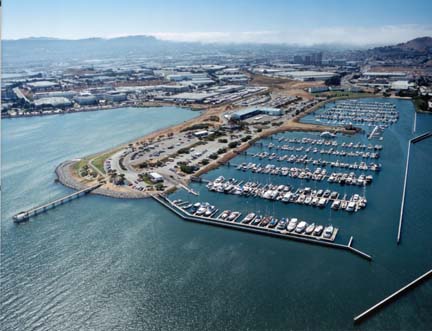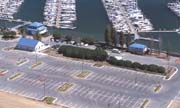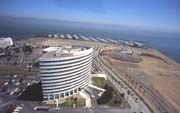
From
Oyster Camps To Biotech To Ferry Hub
Community Rallies to Become New
Ferry Terminal Site
 |
| Excellent
Oyster Point harbor facilities await ferry service to relieve
commute hassles and increase quality of life for Peninsula biotech
workers. |
By Wes Starratt, Senior Editor,
"Bay Crossings"
Oyster Point, a small
harbor, nestled off Highway 101 between South San Francisco and the
Airport is an economic success story, attracting major corporations to
its shoreline. Oyster Point is now positioning itself to become a new
ferry transit hub for the region to serve its booming workforce.
Oyster Point was named for
the oyster camps of the 1870’s. By the pre-World War II years, it
became part of South San Francisco’s "Industrial City,"
hosting steel mills and a wide range of other industries, from paints to
pasta.
In recent decades, the
area’s transformation has been dramatic and complete. Gone is the
heavy industry, and, in its place, Oyster Point has become what the
South San Francisco Chamber of Commerce calls the "Biotech Capital
of the World," with dozens of
biotechnical firm.
Some 80 companies in
biotechnology and related fields now do business out of Oyster Point,
Brisbane and South San Francisco, providing jobs for 24,000 employees.
The largest company is Genentech, Inc. with more than 3,000 employees.
 |
| Existing
parking facilities near Oyster Point harharbor |
Expansion at Oyster Point
continues with construction of more office buildings underway. By 2020,
54,000 employees are expected. The new office buildings have drawn
hundreds of employees commuting from all parts of the Bay Area. Many
Oyster Point workers live in the East Bay and remote locations where
housing prices are more affordable than the Peninsula. Employees lack
direct transit connections between the East Bay and San Mateo County.
Traffic on Highway 101 and the San Mateo Bridge are typically gridlock
making this a very rough commute – sometimes almost an hour and a
half.
North San Mateo County
businesses and City officials have rolled up their sleeves and come up
with creative ways to fill the transit void. They have privately
financed shuttle bus service connecting with rail services provided by
Caltrains and BART. Parking shuttles and large tour buses are now a
common sight at BART stations in Colma, Glen Park and CALTRAIN station.
The area is now turning to
the water as the next option for moving workers and patrons to its
booming commercial center. "We are very pro-ferry service in South
San Francisco. Our businesses are all very excited about it, and we need
to do everything we can to make it happen," says Greg Cochran,
Executive Director of the South San Francisco Chamber of Commerce,
 |
| The
Hitachi building in nearby Brisbane, just one of many high-tech
companies yearning for water transit commute options. And many
more are on the way. |
South San Francisco City
Council member Pedro Gonzalez added, " We are very concerned about
traffic congestion on Highway 101. I’d rather have a ferry terminal
before adding more lanes on the freeway. It is about time that we had
ferries in San Mateo County to link to other parts of the Bay. We are a
new center for jobs. Ferries shouldn’t just stop in Downtown San
Francisco."
The San Mateo County
Harbor District is positioning itself to be among the first communities
to initiate new ferry service. The Harbor District operates a 600-berth
marina for pleasure craft at the Oyster Point Marina. It has plunged
into the lead in planning for ferries to support the economic plans of
South San Francisco and other neighboring cities.
This November, the Harbor
District plans to release the results of a study "A Vision for
Ferry Service at Oyster Point." The study examines what it will
take to bring ferry service to Oyster Point Marina. It will include
information on ridership, impact of ferries coming into the marina,
recommendations for docking facilities, parking needs, and road access,
and shuttle/bus connections.
Harbor Master Johnson
points out that, "With this document, we will be able to request
financial support from various granting agencies on the state and
federal levels and finally have a ferry terminal at Oyster Point
Marina."
This $500,000 study was
the culmination of efforts by the "Water Transit Task Force"
comprised of local business and government leaders. The task force is a
partnership between the City of South San Francisco, the San Mateo
County Harbor District, and the Peninsula Congestion Relief
Alliance.
Supervisor Mark Church
said, "Solving our transportation dilemma is the biggest challenge
of the decade. We need to explore all of the alternative modes of
transportation." San Mateo County has taken significant steps to
make ferries a transportation priority. Water transit is a part of the
San Mateo County-Wide Transportation Plan to the Year 2010.
 |
| Parking
shuttles already serve commuters. When ferry service comes, they’
can be used to get ferryriders from their boats to their offices
quickly and easily. |
Wasting no time, the
Harbor District plans to redesign its breakwater to enlarge the entry to
the boat marina . This will make the marina safer and more accessible
for future ferry operations. It is expected that the redesign will be
paid for with Federal dollars from the U.S. Army Corps of Engineers.
"We are looking at
100-ft-long, 149- passenger catamarans and have been talking with the
Angel Island-Tiburon Ferries, as well as Red & White and Blue &
Gold. At the same time, we are cooperating with Redwood City in its
program to develop ferry service and believe that both services should
be developed at the same time," said Harbor Master Robert Johnson.
Peter Grenell, Manager of
the San Mateo County Harbor District and member of the WTA’s Technical
Advisory Committee pointed, "Interest in water transit at Oyster
Point continues to grow. With continued hard work, ferry service at
Oyster Point may soon become reality!
 |
| Genentech
Shuttle Bus Used to Transport BART Riders from Glen Park BART
Station, S.F. |
The local community’s
interest for ferries was evident at a meeting held this past Summer at
Oyster Point with WTA officials. An enthusiastic group of business and
community leaders reiterated the investment their community has made in
water transit. The importance of ferry service to the East Bay and
Downtown San Francisco was mentioned. South San Francisco business
officials commented that there are many hotel patrons in the South San
Francisco area that could benefit from ferry service to Downtown San
Francisco.
"Oyster Point’s
enthusiasm and accomplishments to establish ferry service is
impressive," said WTA’s CEO, Tom Bertken. "Their work is
very helpful to the WTA in demonstrating the underserved transit needs
of some communities. We hope to show that ferries can be a cost
effective solution for linking Oyster Point with the East Bay,"
added Bertken.
Oyster Point was initially
identified as a potential site for ferries in a study performed by the
Bay Council; the WTA will continue to study Oyster Point as a site for
future ferry terminals. Oyster Point will be analyzed in the WTA’s
environmental review, ridership surveys, intermodal connections and
other technical studies. The WTA’s recommendations will be submitted
to the Legislature in December 2002.
CONTINUE